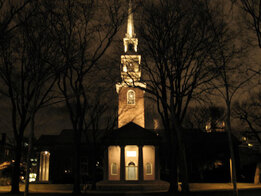
Almost two weeks ago I made my way from the Episcopal Chaplaincy building on Garden Street, through the chill evening to Harvard’s Memorial Church. As I rounded the corner by University Hall, the light of over two hundred candles flickered ahead of me on the steps that face Widener Library, the same steps from which the liturgics of commencement are enacted every spring. This was a vigil to mark, cry out against and be galvanized by the recent rash of LGBT suicides across the United States over the last several weeks. This series of events, and the unprecedented public conversation that has circled about them, has been devastating to many in the Harvard community, particularly LGBT and allied students.
I came to this vigil to represent the Episcopal Chaplaincy (as indeed Episcopal Chaplains across the country have been responding to this rash of violence), which was one of several co-sponsors of the event, and to reach out to LGBT students across the University at this difficult time, letting them know that they are not alone. Voices of people of faith too often stoke the broader cultural dynamics of violence at the root of all of this, and it felt important to be visible as an Episcopal priest standing against that violence. I was also present as a Lecturer currently teaching—and having previously taught—a number of LGBT students deeply impacted by the rash of suicides. Though I’m not sure how many other chaplains were present (there was at least one other), I know I was far from the only professor or staff member there, and that sense of institutional solidarity and support moved me.
But it was also personally important to me to be there as someone who has experienced that broader culture of violence as a member of the LGBT community. Following the example of previous speakers, I spoke in the brief open mic period at the end of the vigil of coming out. In my case, I explained, I happen to have come out twice—first, my sophomore year of college as gay, and then in graduate school as a transgender man (having transitioned from female to male in 2002). I spoke of the importance of community, real community based on authentic relationships, and how important it is right now to reach out to one another across the borders—particularly of faith traditions — that too often separate us.
Two days before the vigil, the combination of the Sunday lectionary readings and the rash of suicides already had me thinking about what it was like to be a young person struggling with the intersection of faith and social stigma. The theme of leprosy in the lectionary readings inspired me to open my sermon with a story of how, when I was in fifth grade, I stumbled upon a library book, Damien, the Leper Priest about Damien de Veuster, a Roman Catholic priest (recently included in the new collection Holy Women and Holy Men) who had served a community living with what is now called Hansen’s Disease. Damien went to this shunned community, fought bureaucrats to get them basic living supplies, built them a physical infrastructure (water supply, housing, etc), bound up their wounds, worked to de-stigmatize the disease, and ultimately contracted it himself, dying as a “leper among lepers.” This was the one book report I did that year that really meant something to me (and the icon below by Robert Lentz is one of my favorites) There was something about the shape of Damien’s ministry in relation to the dynamics of social stigma that rocked my ten-year-old world. It didn’t hurt that as a gender nonconforming kid, stigma was very familiar to me.
The intersection of stigma and faith emerged in another recent Harvard event, a Divinity School panel entitled “Queer Youth and Religious Debates Over Sexuality." When I arrived, I was struck first of all by the Harvard police who stood guard at the doors to the room where the panel was held. Even in its absence, this visible reminder of potential disruption felt overbearing; I could feel it actually raising my heart rate as I listened. While all the remarks were moving, I was struck particularly by those of Professor Mark Jordan who spoke of how “the fights about [LGBT youth] often try to claim them for one camp or another — either religious or queer, but rarely both.” This is one of the peculiar challenges for those of us who are indeed, and have long been, both.
And so as this moment of grief and anger— at Harvard and far beyond—begins to fade from media coverage, we must refuse to forget this episode. I don’t want any of us, whatever our age, sexual orientation, or gender identity, to lose sight of the violence—psychic and physical-- that underlies and emerges from the workings of stigma in all its forms. I'm particularly cheered to read the several statements that communities and individuals across the Episcopal Church have made (see Episcopal Cafe for a collection of them)-- reading them makes me grateful for the support I received as a young person, and galvanized to continue extending that support here and now.
- The Rev'd Dr. Cameron Partridge

 RSS Feed
RSS Feed